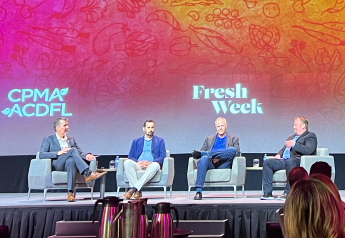Potato and onion suppliers still concerned about foodservice sector

Potato marketers say they worry about the damage COVID-19 is doing to the foodservice sector.
“Potatoes are now on 84% of restaurant menus, and top potato items preferred away from home include fries, hash browns, potato skins, and samosas, while top potato items preferred at home include au gratin potatoes, baked potato, mashed potatoes, potato chips, potato salad, shepherd’s pie, tater drums,” said Rachel Atkinson-Leach, category and brand manager with Bancroft, Wis.-based grower-shipper RPE Inc.
The numbers weren’t good six months into a pandemic that hit restaurants particularly hard, Atkinson-Leach said.
“Nearly one in six restaurants closed either permanently or long-term; 40% of operators think it is unlikely their restaurant will still be in business six months from now if there are no additional relief packages from the federal government,” she said, quoting data from the National Restaurant Association.
“The foodservice industry lost $165 billion in revenue from March–July and is projected to lose $240 billion in sales by the end of the year,” she said.
Atkinson-Leach noted that consumer spending at restaurants remained well below normal levels in August, with sales, on average, down 34%.
“Sixty percent of operators say their restaurant’s total operational costs (as a percentage of sales) are higher than before the outbreak, and on average, restaurant operators say their current staffing levels are only 71% of what they would typically be,” she said.
Uncertainty persists as the holidays approach, said Christine Lindner, marketing manager with Friesland, Wis.-based potato grower-shipper Alsum Farms & Produce Inc.
“While we are fortunate our customer base is primarily retail, there is still a lot of uncertainty in the foodservice industry,” Lindner said.
“It’s really challenging for suppliers to come up with an effective marketing plan for their potatoes since they don’t know how long their customers who operate restaurants will be closed or operate with limitations.”
There’s been a drastic shift and reduction for foodservice with Safer at Home orders in place across the country halting these restaurants to take out/curbside only options, Lindner said.
“Additionally, reduced consumer income will also impact buying decisions at retail in the weeks ahead,” she said.
How long foodservice will remain in such straits is little more than guesswork, said Joe Ange, director of business development with Idaho Falls, Idaho-based onion and potato grower-shipper Eagle Eye Produce.
“It’s hard to predict when foodservice will get back to ‘normal’,” he said.
“We have seen quite a bit this year that is completely unprecedented for our foodservice partners, and we have been impressed to see the foodservice industry finding channels within the supply chain and in their business models that they never had before.”
Restaurants were trying options from inside and outside dining to delivery, marketers note.
“We are optimistic about the future and we will continue to support our foodservice customers in any way that we can,” Ange said.
Onion and potato suppliers had to adjust quickly in the spring, when the pandemic first forced restaurants to close, said Dana Rady, director of promotions, communication and consumer education with the Antigo, Wis.-based Wisconsin Potato and Vegetable Growers Association Inc.
“When restaurants closed for a period of time, the processing sector found itself with excess product, which they tried pushing into the fresh market,” Rady said.
“Initially, this helped bridge the gap of what began as a short crop; however, when restaurants began opening their doors again, the processors took some of that product back, which occurred just before Wisconsin’s new crop came on the market.”
While foodservice had not returned to its pre-COVID-19 level, the sector had shown some signs of improvement, Rady said.
“Many restaurants have found ways to adapt by offering online ordering, curbside pickup and delivery options,” Rady said.
“Thanks to their flexibility and adaptability, they are still able to provide potatoes as an option to their dish offerings.”
Foodservice continues “to evolve” as the pandemic persists, said Rene Hardwick, director of public and industry relations with the Eaton, Colo.-based National Onion Association.
“A new normal may just have to evolve with it,” Hardwick said.
“During the summer months, many restaurants were able to create/use outdoor seating to enlarge their capacity while continuing with social distancing to stay open. As winter is upon us, they may just have to get a little more creative with how they serve food, perhaps marketing their take-out a little heavier, or even putting time limits on how long people can stay within their restaurants to ensure a steady flow of diners.”
That could be a great opportunity for a catering company to find a consumer take-out market, Hardwick said.
“I’m not sure there is a lesson to be learned from that, other than trying to ensure there’s always a market for your onions, regardless of the bottom falling out,” she said.
While foodservice continues to gain momentum and grow, “we can’t change restaurants opening or closing or staying in business,” Hardwick said.
“What we can change as an onion industry is how we communicate our value to foodservice and retail, and that’s what shifting.”







